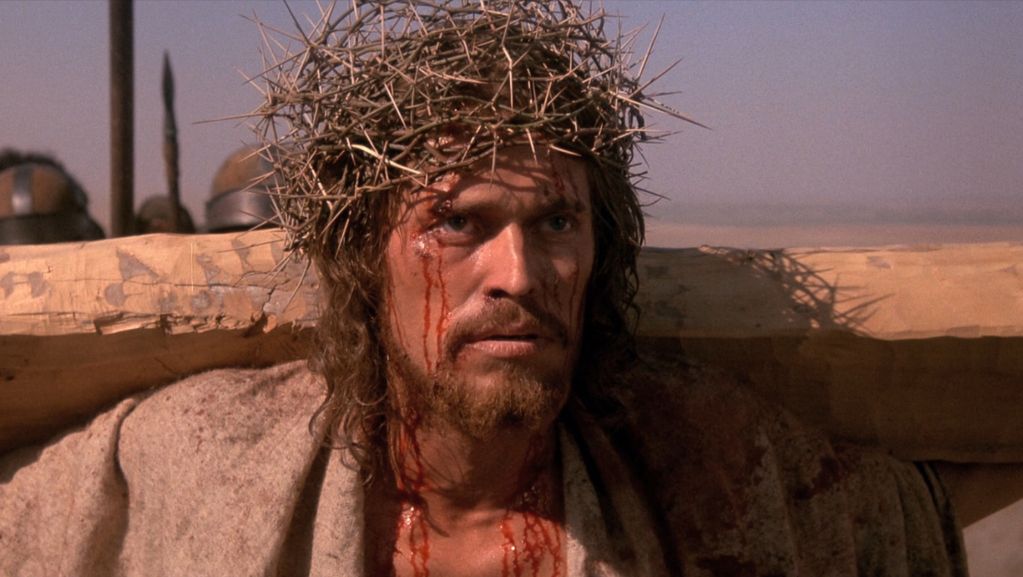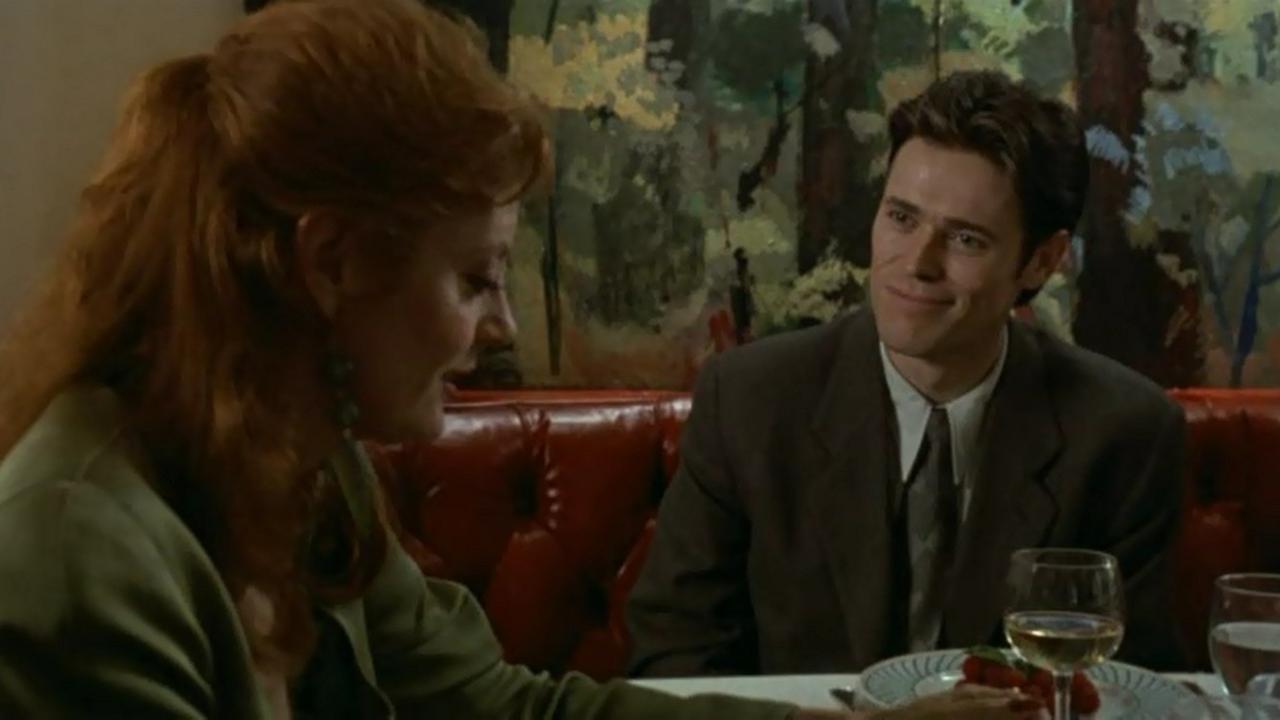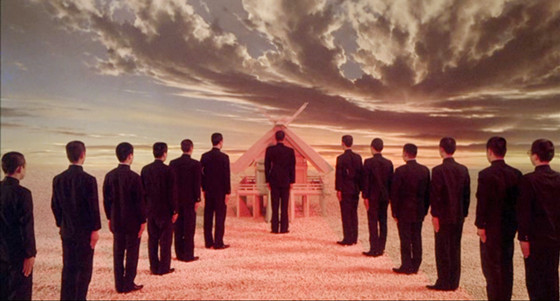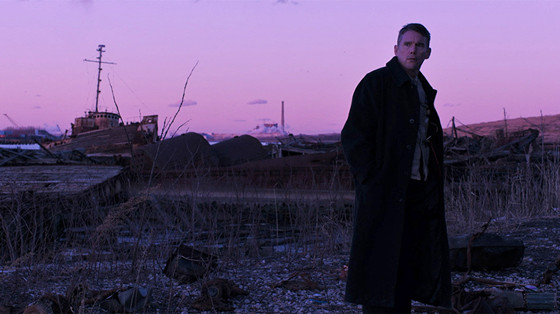6. The Last Temptation of Christ (1988) Written by Paul Schrader

From the 1952 novel by Nikos Kazantzakis, Schrader adapted this unorthodox life of Jesus Christ for Martin Scorcese in the late 1970’s, but for its controversial nature – the novel labeled heretical by both the Catholic and Greek Orthodox churches, and removed from libraries across America – Scorcese was not able to get it made until almost a decade later.
The cause of this controversy is the way in which The Last Temptation seeks to humanize Christ (played by Willem Dafoe) by portraying him as a fallible man of ego, appetite, and doubt, who himself becomes tempted by satan on the cross – to a life of Earthly pleasures, a wife in Mary Magdalene, children, honest labor, and old age – and must himself ask God for forgiveness, and in this saying so much more about our task in being human if even God stands, by our limitations, to fail at it, and need not merely suffer through it.
While the cast of Scorcese regulars and American character actors like Harvey Keitel (as Judas Iscariot) and Harry Dean Stanton (Paul the Apostle) could not feel less at home here in the Biblical Middle East, but lend the film a kind of self-acknowledged staginess that does not make claims at “authenticity” but reduces the film down to its essential spiritual conflicts and truths as embodied by just one set of American actors.
7. Patty Hearst (1988) Directed by Paul Schrader

The only film on this list not written by Schrader, Patty Hearst, from a screenplay by Nicholas Kazan (itself drawing narration from Hearst’s memoir Every Secret Thing) tells the story of the newspaper heiress’ 1974 kidnapping by the radical-left organization the Symbionese Liberation Army while she was a student at University of California, Berkeley, her subsequent imprisonment, and defection to their cause – participation in bank robberies and propaganda releases on their behalf – eventual arrest and trial. The case was controversial in its time for Patty’s claim to being brainwashed and the moral and legal questions that raised.
Natasha Richardson stars as Hearst in a fluid adoption of her different roles from confident student to disempowered captive, apparently sympathetic collaborator, and apparently remorseful convict, all while preserving an ambiguity of motivation in her actions – whether the isolation of captivity so fully broke her identity a new one altogether could be imposed, – her SLA self ‘Tanya’ – whether it was all a performative means of self-preservation, or, like a cop in an undercover movie, if she really grew to sympathize with these people and their cause, to take some thrill in the radical life of an outlaw, knowing at any time she could on her name alone be busted out of it, or if she lost the ability herself to know where the performance began and where it ended.
Across from Patty, the SLA is led by Ving Rhames’ charismatic and commanding Cinque (real name Donald DeFreeze), a self-styled revolutionary who comes off one part earnest militant committed to ideals of black liberation and Marxist revolution, and one part Manson-esque cult leader, revelling in the authority he accrues from his family – mostly women, which he freely helps himself to sex with. As critic George Kouvaros argues there is a performative aspect in Cinque and his soldiers too. They wear costumes of war, repeat political mantras like lines, and play-act on a world-stage of politics, posing for the media while remaining essentially ineffectual common criminals to all but themselves. This disjunction between the SLA and the image they project is characterized by the early scenes of a blindfolded Patty’s imaging her surroundings like a dark Viet Cong prison, only for her to be unmasked and find herself in the prosaic surroundings of a suburban California home.
8. Light Sleeper (1992) Written and Directed by Paul Schrader

Light Sleeper is a clear successor to Taxi Driver but with none of the rage, none of the squalor. If Taxi Driver is the masterpiece of Schrader’s “man in a room” films Light Sleeper is the masterpiece all Schrader’s own – his words and his world.
John LeTour has made a respectable career for himself in high-end drug dealing, insulated from Travis Bickle’s world of street crime. A clean cut cultured yuppie set, absorbed in astrology, synchronicity, and other superstitions – nightclub socialites and self-styled aristocrats. His clientele are easy. He’s clean. One of the lucky ones, he’s made it to middle age.
But now his boss Anne (Susan Sarandon) is getting older too, and wants to go legit, go into the cosmetics market, and LeTour will be on his own for the first time in a long time. Maybe, he says, he will go into music production. Maybe he will be a good person. He is adrift through this last run of jobs. Danger seems to lurk. He doesn’t sleep, he writes. He puts his faith in superstition, walking around nights waiting for the vice squad to get him. LeTour’s world is criminal and yet completely detached, soft-focus and unreal to the sudden intrusions of death. He’s got to get out — he feels he never will. The future is uncertain, and the past haunts him. It’s an early morning comedown for the cocaine 1980’s that with Michael Been’s slick soft rock crooning projects an eerie calm.
LeTour runs into ex-girlfriend Marianne one night (Dana Delany) and four years clean she wants nothing to do with him and his dealing. He wants to get back together with her, has to convince her he’s changed. Meanwhile a wealthy woman found overdosed in the park has brought the cops down on mid level dealers all around town, and LeTour finds himself followed by a homicide cop Bill Guidone (Robert Cicchini), while his customers – the self-destructive Eddie (Paul Jabara), the sociopathic Tis (Victor Gabrer), and a cokehead theologian (David Spade) among them – continue dragging him back into trouble.
When a tragic death occurs close to John and the media begins reporting information he knows to be false he is forced to take matters into his own hands, a step in clarity toward death, and one out of the fog of uncertainty he has found himself in, toward the future.
9. Mishima: A Life in Four Chapters (1985) Co-Written and Directed by Paul Schrader

In what might be Schrader’s directorial masterpiece, Mishima: A Life in Four Chapter explorers the controversial Japanese writer’s radical life, works, and death as a far-right extremist and homosexual obsessed with the warrior ideals of feudal and Imperial Japan, a novelist, playwright, and filmmaker, and the leader of the paramilitary Shield Society which stormed the offices of Japan’s Eastern Army Headquarters on November 25th, 1970 and took hostages with the demands of assembling an audience for a call to revolution Mishima delivered to the army before committing ‘seppeku’ (ritual suicide) before his captive audience alongside the four other members of the Shield Society.
It is no small surprise Mishima even got made, a free-form biopic about a homosexual right-wing extremist shot in Japan with a Japanese cast and crew to be released to American audiences in the midst of the blockbuster 1980’s, but thanks to the support of Francis Ford Coppola and George Lucas Schrader was able to get it off the ground with a $5,000,000 budget.
Mishima is Schrader at his most flamboyant and grandiose: brightly colored abstract sets cast against a theatrical abyss and the many masks of an always contradictory man portrayed by different actors, Ken Ogata on the day of his suicide and by Gô Rijû, Masato Aizawa, Yasosuke Bando, Kenji Sawada, and Toshiyuki Nagashima in flashbacks and fantasies besides.
The film weaves the fact of Mishima’s life into aspects of his fiction in a hallucinatory portrait of a man and his obsessions, played by a present-tense Ken Ogata, and five different actors besides in flashback and fantasy.
One doesn’t need to look too hard to see Schrader’s fascination with this character, the artist turned violent-actor who allows Schrader to dramatize and express his own existential and hypermasculine – even homoerotic – fixations on violence and meaningful death.
10. First Reformed (2017) Written and Directed by Paul Schrader

His most overt homage to Schrader’s European arthouse roots yet, First Reformed draws as heavily on Bresson’s Diary of a Country Priest (1951) and Ingmar Bergman’s Winter Light (1963) – both in form and narrative, shot in a 4:3 of static compositions and pensive tracking shots and a richly textured asceticism – a sensitivity to sound and material – and merging those film’s stories of an ailing priest suffering a crisis of faith and a priest engaged in counsel of a suicidal parishioner with the existential violence of Schrader’s “man in a room” films.
Ethan Hawke plays with quiet reserve the Rev. Ernst Toller, the deeply serious priest of the small Snowbridge, New York First Reformed Church, home to a dwindling congregation, and kept around by its owners – the materialistic Abundant Life megachurch run by Pastor Joel Jeffers (Cedric the Entertainer) – mostly for historical interest, for its centuries old structure and use in the underground railroad.
After service one day Toller is asked by a member of his church Mary (Amanda Seyfried) to speak to her husband Michael (Philip Ettinger) who is involved in the environmental movement and believes with the future they are left with it is not right to bring a child in the world, and wants the pregnant Mary to get an abortion. Toller tries to counsel him in the ways of hope, but when Toller discovers a suicide-bomb vest among Michael’s things it becomes clear the despair had gone much deeper than it seemed. Meanwhile Toller struggles with his own crises of faith, and the development of an undiagnosed illness he prefers to ignore than have looked at.
And though reaching an apocalyptic despair as bleak as any of Schrader’s works, the film contains a strong moral core and ends on an optimistic note unprecedented in its cycle.